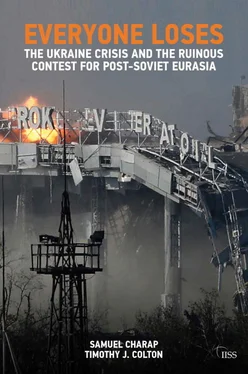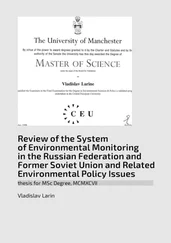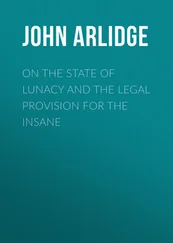The lives of many rank-and-file Ukrainians in the conflict zone have been turned upside down by all that has happened. In government-controlled stretches of Donetsk and Luhansk, where livelihoods had depended on ties with the provincial capitals now under rebel control, economic activity has contracted steeply. And the tightening of the security regime at the line of contact has made crossing it an exorbitantly time-consuming activity, with queueing often taking 24 hours or more. In mid-2016, OHCHR stated that ‘Ukrainian authorities have often run afoul of the principle of non-discrimination through adopting policies that distinguish, exclude, and restrict access to fundamental freedoms and socio-economic rights to persons living in the conflict-affected area.’ [11] Office of the UN High Commissioner for Human Rights, ‘Report on the Human Rights Situation in Ukraine 16 February to 15 May 2016’.
Within the separatist territories, shortages of goods, and black markets, wage arrears and lawlessness are among the hardships of daily life. Since the start of the conflict, separatists have taken over at least 50 state-owned mines and looted Ukrainian- and foreign-owned businesses. [12] Michael Bird, Lina Vdovii and Yana Tkachenko, ‘The Donbass Paradox’, The Black Sea, http://www.theblacksea.eu/donbass/ .
For the country as a whole, the economic burden of the conflict and the revolution that preceded it has been extremely heavy. The World Bank reports that GDP contracted by 7% in 2014, only to fall by 10% in 2015. The Bank forecasted that the economy could grow by 1% in 2016 in a best-case scenario involving peace and progress on reform, but even that is merely the result of what economists call base effects, that is, an economy can only go up after hitting rock bottom. Ukrainians have been pummelled by inflation, with consumer prices rising 25% in 2014 and a whopping 43% in 2015. Industrial output dropped by 20% in 2014 and 13% in 2015. The currency has lost more than 60% of its value against the dollar since 2014. As the conflict in the east drags on, the economic domino effects can only get worse. As Ukraine’s heartland for mining and metallurgy, the Donbas accounted for 16% of the country’s GDP, 25% of industrial output and 27% of exports in 2013, the year before the conflict. Predictably, the nationwide macroeconomic downturn has seriously complicated the lives of ordinary people. Household expenditures were down by 20% in 2015, reflecting cutbacks in spending on food and other necessities; the calorific content of food consumed fell by 18% on average. [13] Andrei Revenko, ‘Kak my zhivem: udruchayushchie itogi 2015-go i perspektivy 2016-go’, Zerkalo nedeli , 16 July 2016, http://gazeta.zn.ua/macrolevel/kak-my-zhivem-udruchayuschie-itogi-2015-go-i-perspektivy-2016-go-_.html .
A Gallup poll in late 2015 reported that 79% of Ukrainians viewed the country’s economic situation as ‘poor’, while only 9% reported that they were thriving, compared with around 56% who said they were struggling and 36% who were suffering. [14] Zach Bikus, ‘Ukrainians’ Life Ratings Sank to New Lows in 2015’, Gallup, 4 January 2016, http://www.gallup.com/poll/187985/ukrainians-life-ratings-sank-new-lows-2015.aspx .
One formidable source of economic distress has been the rupturing of commercial ties with Ukraine’s giant neighbour, Russia. Thus far, the contraction of Ukraine’s GDP, and particularly the collapse of energy-intensive industries in the east, has dampened demand for Russian gas. If and when its economy recovers, Ukraine will have little alternative to re-establishing the gas relationship with Russia. ‘Reverse flow’ of Russian gas from Europe has helped Ukraine get through the past few years, but all possible pipelines operating at full capacity can currently provide Ukraine with no more than 12bn cubic metres (bcm) a year; in 2013, Ukraine imported 27bcm of Russian gas. [15] Calculations provided to the authors by Pierre Noel, Senior Fellow for Economic and Energy Security, International Institute for Strategic Studies. See also Simon Pirani, ‘Ukraine’s Imports of Russian Gas: How a Deal Might Be Reached’, Oxford Institute for Energy Studies, July 2014, p. 4, https://www.oxfordenergy.org/wpcms/wp-content/uploads/2014/07/Ukraines-imports-of-Russian-gas-how-a-deal-might-be-reached.pdf .
In the past, the gas relationship with Russia was a key source of fiscal stability. In 2013 Gazprom poured US$3.1bn in transit fees into Ukrainian coffers, a sizeable percentage of gross state revenue. With alternative pipelines from Russia to Europe that bypass Ukraine via the Black and Baltic seas coming online in the next few years, the future of Kyiv’s gas-transit income is in doubt.
Ukraine’s structural dependency on Russia is not confined to gas imports and transit. One-third of its total exports went to Russia in pre-crisis 2013, or about the same as to the EU. By the Ukrainian government’s own estimates, it lost US$98bn in trade in 2014 and 2015 from sanctions imposed by Russia. [16] World Trade Organization, ‘Trade Policy Review Report by Ukraine’, 15 March 2016, p. 10, https://www.wto.org/english/tratop_e/tpr_e/g334_e.pdf .
The net effect is significantly greater because of the composition of Ukraine’s exports. It mostly sells metal ore, ferrous metals, and grain and other agricultural goods to Europe. To Russia, by contrast, it has exported machinery, transport services and industrial products – that is, value-added goods and services that tend to provide more and higher-paying jobs. [17] L.M. Grigor’ev, A.V. Golyashev and E.V. Buryak, ‘Sotsial’no-ekonomicheskii krizis na Ukraine’, Analytical Center for the Government of the Russian Federation Working Paper, September 2014, p. 26, http://ac.gov.ru/files/publication/a/3586.pdf .
Several huge enterprises, mainly in the defence and aerospace industry, had only Russian clients before the crisis. Kept afloat for now by subsidies and pre-existing contracts, they will soon either go bankrupt or have to be retooled. The Yuzhmash plant in Dnipro (formerly Dnipropetrovsk), which has subsisted since 1991 mostly by producing and servicing missiles for Russia, now works only one day a week and owes millions of dollars in back wages to its workers; the Antonov firm in Kyiv, which had produced large cargo planes jointly with a Russian partner, suspended production in March 2016.
While undergoing economic and conflict-related pain, Ukrainians have seen only modest improvements in governance since the Maidan Revolution. Several significant reforms have been enacted, but day-to-day realities in Ukraine have changed little, despite the soaring rhetoric often used by Ukrainian officials and their Western backers. National polls conducted in late 2015 found that nearly 80% of Ukrainians believed that the level of corruption was the same as or worse than before the revolution. Only 8% of Ukrainians had confidence in the national government, just 19% said the country was headed in the right direction, and Petro Poroshenko’s presidential approval rating fell to an abysmal 17%, ten points lower than Viktor Yanukovych’s on the eve of his overthrow. [18] UNITER, ‘Corruption in Ukraine: Comparative Analysis of Nationwide Surveys of 2007, 2009, 2011 and 2015’, April 2016; Julie Ray, ‘Ukrainians Disillusioned With Leadership’, Gallup, 23 December 2015, http://www.gallup.com/poll/187931/ukrainians-disillusioned-leadership.aspx .
Ukrainian politics have also become more polarised and rife with extreme discourse and behaviour. National identity, it is true, has been vigorously contested ever since the country’s independence in 1991. Divergent visions of culture, history and language set apart many in the south and east from those in the west and centre. Given the highly centralised nature of the Ukrainian government, those in charge in Kyiv have always had the power to impose their views on the rest of the country. Before 2014, though, factionalism and disorganisation within the Verkhovna Rada and executive branch prevented any single part of the country from locking in total dominance. The Maidan Revolution marked a qualitative shift in this regard. As noted above, far-right nationalists were the armed vanguard of the uprising, and the post-revolutionary government was dominated by representatives of western portions of the country. Support for the Maidan movement was minimal in the south and east. One public-opinion survey in February 2014 showed that only 20% in the east (including the Donbas) and 8% in the south (including Crimea) sympathised with the Maidan protesters; this figure was 80% in the west and 51% in the centre. [19] Survey conducted by the Kyiv International Institute of Sociology, http://kiis.com.ua/?lang=ukr&cat=reports&id=231&page=1&y=2014&m=2 .
The south and east have been increasingly marginalised since the revolution. The Party of Regions, the political machine prevalent there from the late 1990s onward, fell apart after Yanukovych’s fall, while the Communist Party of Ukraine, the other major party with support there, was banned by a Kyiv court in September 2015. The annexation of Crimea excluded 2m southerners from the polity, and the Donbas war disenfranchised those in rebel-held territory and also the hundreds of thousands of internally displaced Ukrainians and residents of districts near the line of contact where martial law has been invoked. In the first year of the warfare in the east, most front-line troops were not from regular army units but paramilitary volunteer battalions, some of which had abrasively nationalist leanings; one featured the neo-Nazi Wolfsangel on its banner. [20] Tom Parfitt, ‘Ukraine Crisis: The Neo-Nazi Brigade Fighting Pro-Russian Separatists’, Telegraph , 11 August 2014, http://www.telegraph.co.uk/news/worldnews/europe/ukraine/11025137/Ukraine-crisis-the-neo-Nazi-brigade-fighting-pro-Russian-separatists.html .
Читать дальше











